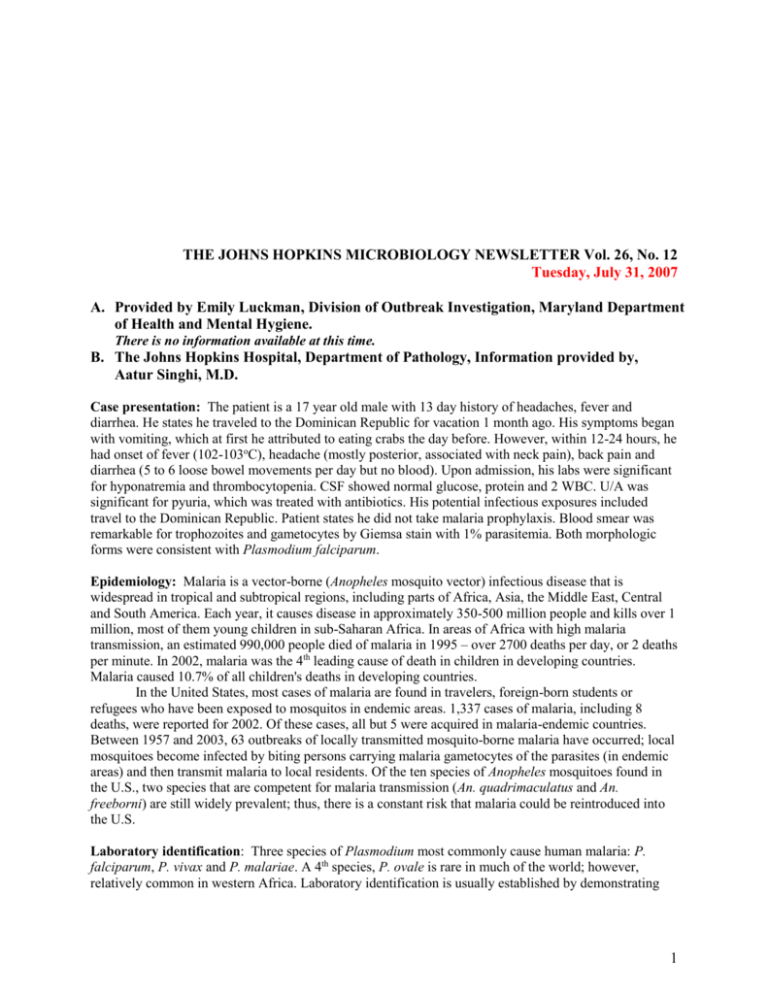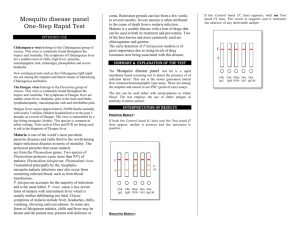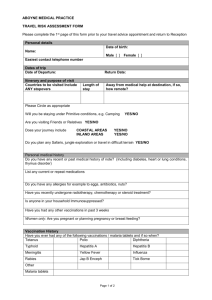No 12: Malaria - Johns Hopkins Medicine
advertisement

THE JOHNS HOPKINS MICROBIOLOGY NEWSLETTER Vol. 26, No. 12 Tuesday, July 31, 2007 A. Provided by Emily Luckman, Division of Outbreak Investigation, Maryland Department of Health and Mental Hygiene. There is no information available at this time. B. The Johns Hopkins Hospital, Department of Pathology, Information provided by, Aatur Singhi, M.D. Case presentation: The patient is a 17 year old male with 13 day history of headaches, fever and diarrhea. He states he traveled to the Dominican Republic for vacation 1 month ago. His symptoms began with vomiting, which at first he attributed to eating crabs the day before. However, within 12-24 hours, he had onset of fever (102-103oC), headache (mostly posterior, associated with neck pain), back pain and diarrhea (5 to 6 loose bowel movements per day but no blood). Upon admission, his labs were significant for hyponatremia and thrombocytopenia. CSF showed normal glucose, protein and 2 WBC. U/A was significant for pyuria, which was treated with antibiotics. His potential infectious exposures included travel to the Dominican Republic. Patient states he did not take malaria prophylaxis. Blood smear was remarkable for trophozoites and gametocytes by Giemsa stain with 1% parasitemia. Both morphologic forms were consistent with Plasmodium falciparum. Epidemiology: Malaria is a vector-borne (Anopheles mosquito vector) infectious disease that is widespread in tropical and subtropical regions, including parts of Africa, Asia, the Middle East, Central and South America. Each year, it causes disease in approximately 350-500 million people and kills over 1 million, most of them young children in sub-Saharan Africa. In areas of Africa with high malaria transmission, an estimated 990,000 people died of malaria in 1995 – over 2700 deaths per day, or 2 deaths per minute. In 2002, malaria was the 4th leading cause of death in children in developing countries. Malaria caused 10.7% of all children's deaths in developing countries. In the United States, most cases of malaria are found in travelers, foreign-born students or refugees who have been exposed to mosquitos in endemic areas. 1,337 cases of malaria, including 8 deaths, were reported for 2002. Of these cases, all but 5 were acquired in malaria-endemic countries. Between 1957 and 2003, 63 outbreaks of locally transmitted mosquito-borne malaria have occurred; local mosquitoes become infected by biting persons carrying malaria gametocytes of the parasites (in endemic areas) and then transmit malaria to local residents. Of the ten species of Anopheles mosquitoes found in the U.S., two species that are competent for malaria transmission (An. quadrimaculatus and An. freeborni) are still widely prevalent; thus, there is a constant risk that malaria could be reintroduced into the U.S. Laboratory identification: Three species of Plasmodium most commonly cause human malaria: P. falciparum, P. vivax and P. malariae. A 4th species, P. ovale is rare in much of the world; however, relatively common in western Africa. Laboratory identification is usually established by demonstrating 1 parasites in thick and thin blood films. Blood specimens are ideally collected just prior to the next anticipated fever spike or at the onset of fever. It may be necessary to draw blood samples several hours apart to demonstrate infection or to diagnose the species as the number and morphologic stages of parasites vary during the cycle. Proper identification of malarial parasites requires a systematic approach based on the observation of a few key factors: appearance of infected erythrocytes, appearance of parasites and stages found. Of the four species, infections with P. falciparum should be recognized as early as possible because the disease can be particularly severe, rapidly progressing to death. For P. falciparum, the peripheral smear displays tiny ring forms that occupy < 1/3 diameter of the RBC. Not infrequently multiple forms are seen within one RBC, with 2 nuclei in the same ring. Infections may be heavy, involving 20% or more RBCs. The tiny rings often appear attached to the cell membrane (“appliqué” effect). Schizonts are rarely observed in stained peripheral smears with P. falciparum. The only forms seen, except in terminal infections are early ring forms and gametocytes. The presence of banana- or crescent-shaped gametocytes is diagnostic. However, these may be absent in early stages of infection and usually begin to appear after 7 to 10 days from fever onset. Species specific serologic tests for malaria can be useful; however, they do not reliably differentiate current from past infection. Sensitive and specific IFA tests using antigens from the 4 human species are available from the CDC. Detection of parasite specific DNA by PCR is more accurate than microscopy, however this requires specialized equipment and reagents that smaller labs may not be able to afford. Clinical aspects: Most patients infected with P. falciparum become symptomatic within 1 month of exposure. Common symptoms of malaria include paroxysm of fevers, shaking chills, sweats, cough, fatigue and malaise. The classic febrile paroxysm begins with a period of shivering and chills, which lasts for approximately 1-2 hours and is followed by a high fever. Finally, the patient experiences excessive diaphoresis and their body temperature drops to normal or below normal. Patients with malaria can develop anemia and other manifestations such as diarrhea, abdominal pain, headaches and muscle aches. P. falciparum can result in high parasitemia, which leads to severe hemolysis with hemoglobinuria and profound anemia. Infected RBCs become sequestered in small vessels and may lead to occlusion. Involvement of the brain is known as cerebral malaria, where the patient becomes disoriented, progressing to delirium, coma and often death. Active malaria infection with P. falciparum is a medical emergency requiring hospitalization. Infection with the other species can often be treated on an outpatient basis. Treatment of malaria involves supportive measures as well as specific antimalarial drugs. Chloroquine is considered to be the antimalarial drug of choice. However, resistance of P. falciparum to chloroquine has spread recently from Asia to Africa, making the drug ineffective. Unfortunately, chloroquine-resistance is associated with reduced sensitivity to other drugs such as quinine and amodiaquine. Plasmodium life cycle: Malaria in humans develops in 2 phases: an exoerythrocytic (hepatic) and an erythrocytic phase. When an infected Anopheles mosquito obtains blood from its host, it passes Plasmodium sporozoites from the mosquito’s saliva into the host’s bloodstream. The sporozoites migrate to the liver and within 30 minutes of introduction, they infect hepatocytes multiplying asexually and asymptomatically for a period of 6–15 days. During this so-called dormant time in the liver, the sporozoites are often referred to as hypnozoites. Once in the liver these organisms differentiate to yield thousands of merozoites which, following rupture of their host cells, escape into the blood and infect red blood cells, thus beginning the erythrocytic stage of the life cycle. Within circulating erythrocytes the parasites multiply further, asexually, periodically breaking out of their hosts to invade fresh RBCs. Several amplification cycles occur. Thus, classical descriptions of waves of fever arise from simultaneous waves of merozoites escaping and infecting red blood cells. Some merozoites turn into male and female gametocytes. If a mosquito pierces the skin of an infected person, it potentially picks up gametocytes 2 within the blood. Fertilization and sexual recombination of the parasite occurs in the mosquito's gut. New sporozoites develop and travel to the mosquito's salivary gland, completing the cycle. References: Bledsoe, GH. Malaria primer for clinicians in the United States. South Med J 2005; 98(12): 1197-204. CDC Malaria website. Koneman's Color Atlas and Textbook of Diagnostic Microbiology, 6th edition. LWW, 2005. McPherson RA and Pincus, MR. Henry’s Clinical Diagnosis and Management by Laboratory Methods, 25th edition. Elsevier, Philadelphia, 2007. Murphy S, Harrison T, Hamm H, Lomasney J, Mohandas N, Haldar K. Erythrocyte G protein as a novel target for malarial chemotherapy. PLoS Med 2006; 3(12): e528. Sturm A, Amino R, van de Sand C, Regen T, Retzlaff S, Rennenberg A, Krueger A, Pollok JM, Menard R, Heussler VT. Manipulation of host hepatocytes by the malaria parasite for delivery into liver sinusoids. Science 2006; 313: 1287-1490. 3






